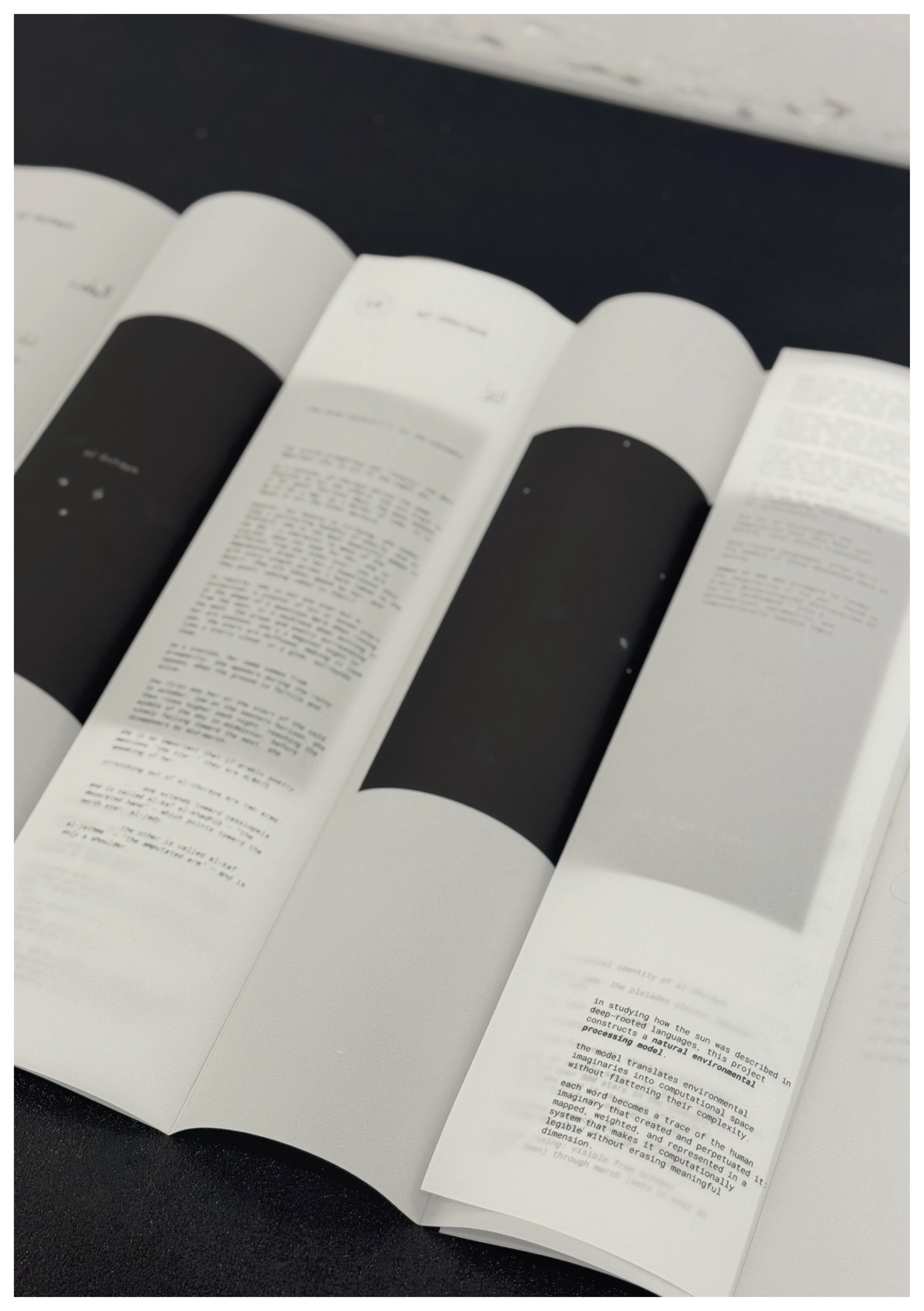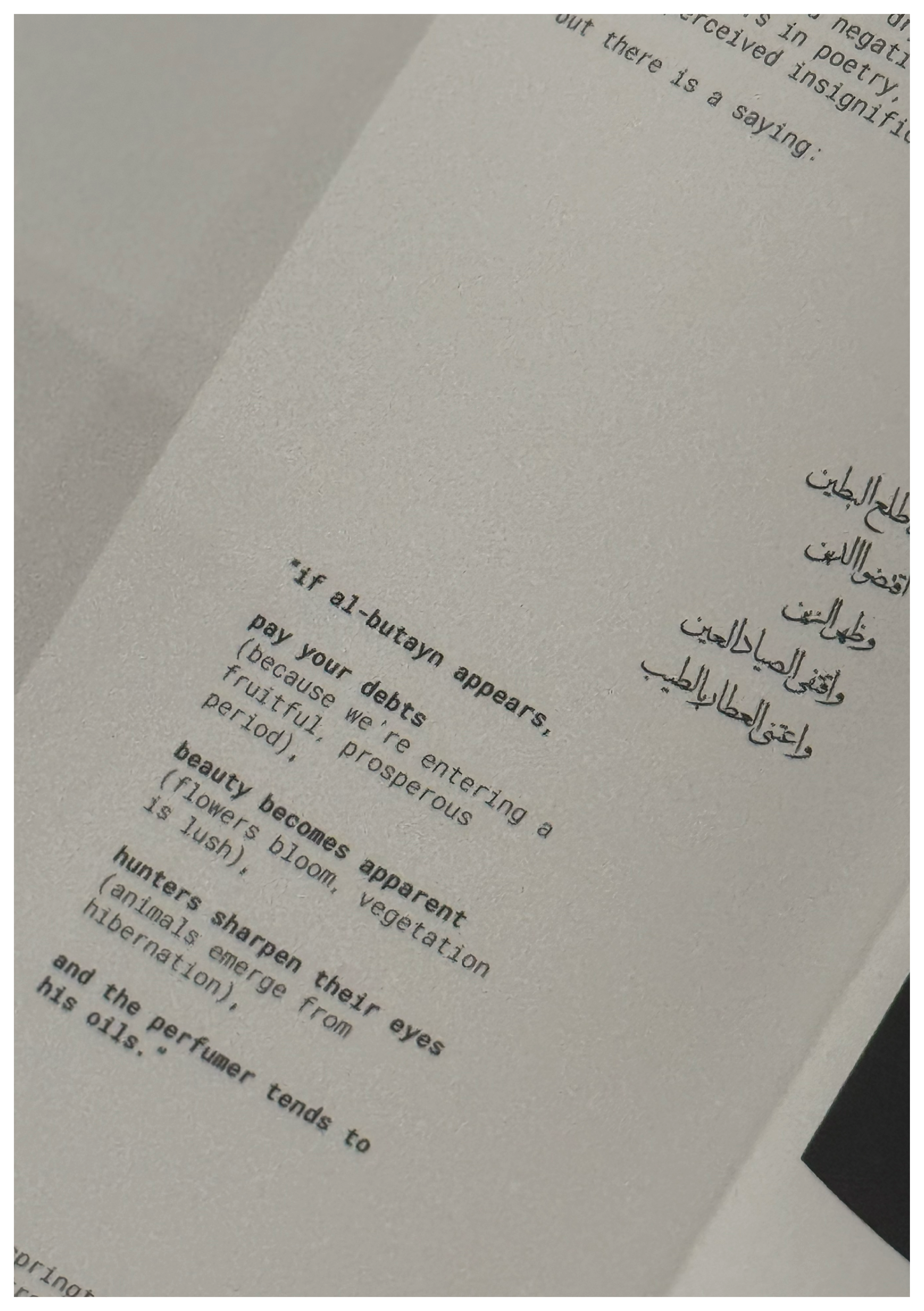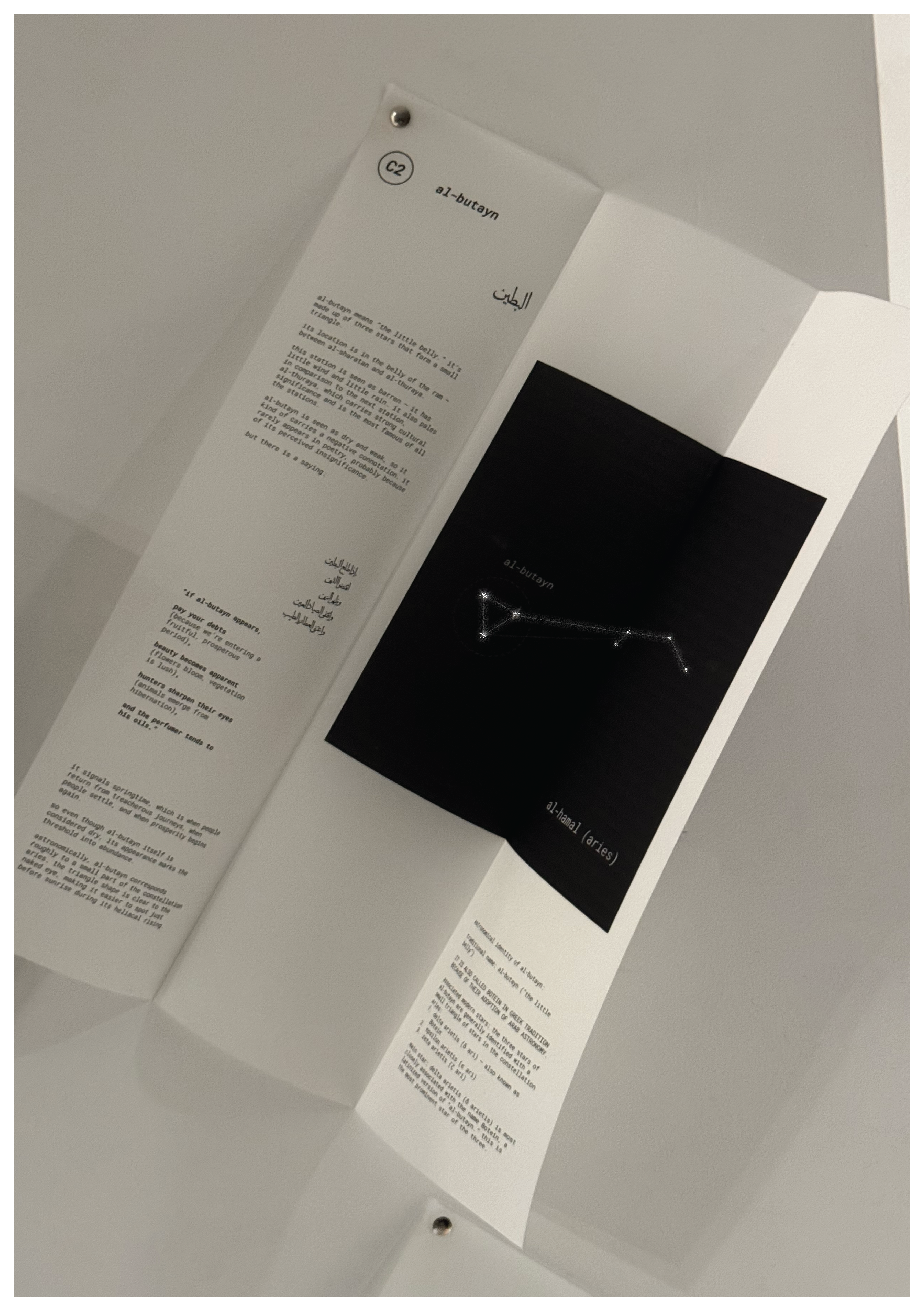Resistant Atlas - Names of the Sun
Badriyah Alsalem
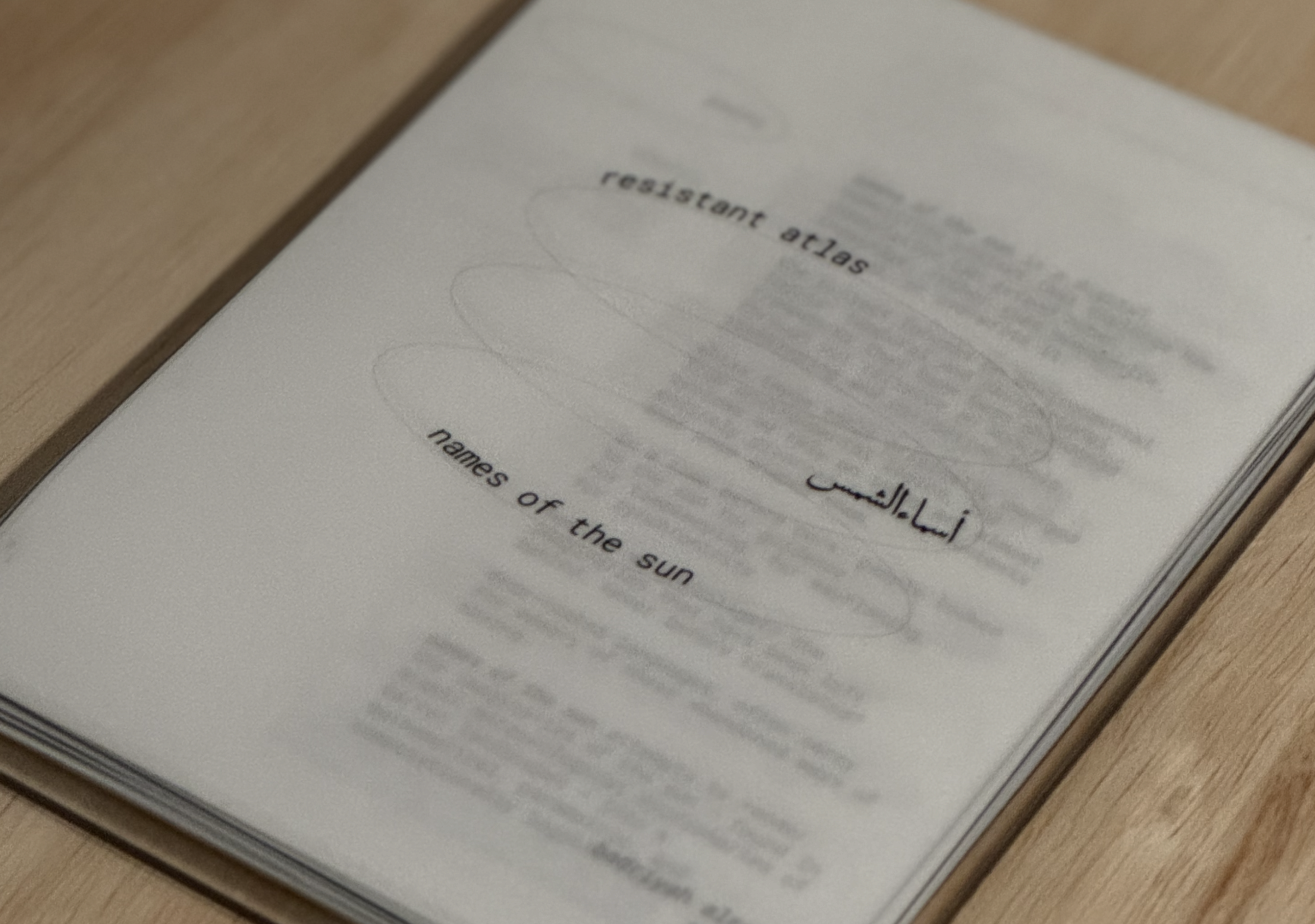
Resistant Atlas is an ongoing digital humanities project that attempts to resist Western temporal and spatial frameworks, those which we’ve come to accept as reality through the very tools we use to measure and navigate the world.
Through parametric frameworks, computational tools, linguistic processing, and physical artifacts, the atlas challenges the neutrality of modern timekeeping and proposes embodied, culturally-rooted environmental logics.
The atlas asks, 'How can time/space be experienced, or even intuitively understood, rather than dictated?
What if computation contextualized, rather than flattened, knowledge?
What if technology extended human experience, rather than suffocated it?
CONTEXT
The kickoff of the research was understanding that humans are really not that imaginative. In every phase of invention, our imagination and understanding of time and space relied on the tools that we used to measure them. In the era of the sundial, the time adopted the attributes of the sun, becoming encompassing, omnipresent, constant, dependable, untouchable. In the era of the water clock, time suddenly became tangible, able to be wasted, to be measured, to be gifted, to be saved. And so it continued, evolving as our materials and techniques did, until we come to our way of understanding time today - dictated, controlled, inaccessible, and unchallenged. A rigid, unquestioned facet of reality.
Every era’s timekeeping reflects the politics of its day. Ours is no exception. Our time is decided on in an office in France, sent to a few other offices around Europe, then to US military bases, before it arrives to our phones. The intangibility, as well as the intentional ambiguity of it comes as no surprise. And naturally, time's carefully embedded politics come as no surprise either.
In understanding the non-neutrality of these time telling tools, one begins to wonder; what does open-source time look like? What if telling time could be a direct process? If I could measure life, and communicate time, without it passing through all of those hands?
Taking a step back..
This questioning began in 2020, when I visited the desert for the first time, and saw the sky in all its glory. The stars, the moon, the planets... their rhythms and movements made sense to me. I decided to take a semester off my undergraduate studies in Kuwait University and learn time-telling and navigation through astronomy. Naked-eye, observational astronomy. Without any equipment, just as every civilization did for hundreds of thousands of years before time became a dictated concept. How did people read the sky?
As the night sky became more familiar to me, a new environmental logic began to reveal itself. I learned from the bedouins living in that desert (Al-Gharameel, Al Ula, Saudi Arabia), many of whom spoke in a type of dense, heavy Arabic that I struggled to understand at first. They seemingly spoke in tongues, documenting sharp, scientific observation, gathered from 2000 years of observing the sky, into beautiful poetry and Arabic prose.
Slowly understanding the complexity of the language, and the precise scientific observation it offered, I realized that this environmental logic, the embodied, intuitive way of reading nature, was the same logic the people of the deserts, of the seas, of the mountains, of the arctic, of the plains, would live their lives.This was how they would understand and communicate time and space. Through this logic and firsthand observation. This was how the first accurate maps were drawn, pre-satellites! This was how the calendars we use today were created! How the compass was halved and quartered!
It was all wonderfully advanced and complex, but at the same time, much more intuitive and harmonic than I ever could imagine with my iPhone brain or my Google Maps brain. And now, my ChatGPT brain.
I spent a few months there, and here is a journal entry from that time:
“I’m so content.
I’m in Al-Gharameel desert. This spot, these stars, feel like home. I’m on my back with my arms in the air and I’m tracing the constellations that will lead me back to civilization. I’ve learned to use my body. My fingers measure the degrees between the stars and my arms can gauge the rotation of the sky.
After a while with my hands up, the roles reverse.
It feels like I’ve been orchestrating the harmonious orbits above me rather than measuring them.
I’m breathing in the culture. Language, environment, sky, land, peace, need, shelter, direction, awareness. These are ideas discussed from the distance of continents and centuries. But here, everyday I speak to a woman and her grandson who recognize me by the sound of my feet on the sand. I sit with the old bedouin men who don’t mind how I’m young, female, and foreign. They laugh at my accent and the simpleness of my Arabic. Yet, they teach me how everything came to be. They surprise me. With every line of poetry, they have the quantitative data to back it up. It all connects. I’m experiencing a new kind of clarity - one that surfaced from a calculated complexity unique only to nature. I’ve observed and studied patterns and paths, points and lines, far away from their usual digital context.
This is where it all came from, after all. Looking up at the sky’s ambiguity allowed our minds to wander into the study of time, math, philosophy, religions, and all of what makes us feel human, like vulnerability, reassurance, and wonder…”
And another, this one is dated October 2nd, 2021 (after quite some time in between those deserts and my home, Kuwait City)
"Once again, I'm in the middle of Al-Gharameel desert. I’m on my back, my arms up in the air. I’m laying on a pillow but my back is on the ground.
I can see everything above me. I don’t want to take my eyes off of the sky. I feel like I’ll miss something, even though these stars have been above me before I was born, before my ancestors were born, before the earth was formed.
These stars have been here before we were able to perceive them. And yet, I don’t even want to blink.
The silence is deafening. It’s a different kind of silence. It’s almost heavy. It feels like cotton in my ears.
My breathing seems so loud here.
The gharameel (rock formations) surrounding me make the desert feel small. Like this spot is protected just for me. It doesn’t feel open. I don’t feel exposed. I feel surrounded and safe. I’m being watched over.
My hands keep reaching up to touch the stars for some reason. I always do this without realizing, and I only notice after my arms start to feel sore from keeping them up.
No matter how hard I try, I will never touch the stars... Yet, my arms stretch upwards,
and I realize it’s not about the feeling of touching, but about the act of reaching.
I’m a bit chilly, but the tea in my stomach is warm and sweet.
These moments of reflection are so fleeting. I need to write it down as it's happening.
I look back at Jupiter, the planet that keeps my time. It’s almost behind the mountains, which means it’s nearly time to go. I glance back at brilliant colors of the Milky Way. I'm addicted to feeling so small, and allowing the universe to remind me of it. Maybe I can ignore Jupiter’s warnings for a few more moments."
and another:
“My chair is reclined back, my knees are curled to my chest, and I’ve mapped out all the stars with my hands.
Polaris and Cassiopeia are one hand apart. Al Thuraya and Aldebaran are three fingers apart.
The process felt like it took forever, but eventually, it was as if I had touched every star in the sky.
I’ve been looking up for too long. I feel untethered. My balance is off. I’ve drifted too far.
So I took off my shoes and walked barefoot in the sand for as long as I could. To bring myself back to Earth.
I mapped out the stars because I know that in the city, with all the lights, I’ll only be able to see one or two stars as reference points. So I’m going to use my hands to map out the rest from memory."
When finally returning back to the city, the time and space I had known my entire life - the clock, navigation, calendars, all did not make sense to me any longer. I felt as though I had broken through it, and I could no longer understand it backwards. But in trying to continue on my research, I realized how impossible it was to simply research this environmental logic from Western sources. To find traces of it in what we know as time today. Outside of the desert, when I couldn't see the sky, I struggled to piece it together. The temporal and spatial frameworks all my research was based on were no longer reliable to me. It all fell apart.
And with the lights of the city, when I could no longer see the night sky, I felt lost. I could't look up to know where I was going, or how much time had passed.
So I went back.
I volunteered to teach what I had learned. I wanted to spread the knowledge, but also, through teaching, I knew I could learn so much more. A hiking company interested in cultural tourism gave me the space to design my own program. I began taking people on a two-hour road trip into the desert, seating them on the ground beneath the stars, and guiding them through a lecture on how to use the sky as a compass, a map, a clock, and a calendar; through stories, poetic fragments, and historical observations I had gathered during my journeys in that very same desert.
It was the most magical thing — the sky was my theater. I moved from one end of the stage to the other, using my hands, my voice, urging people to look up, then behind them, then east, then west. Everyone trusted me to guide them through the desert. I made friends from all over.
The night sky stepped back into a role it had briefly abandoned: connecting the entire world through one simple, shared gesture: to look up.
I did this for about 10 months, taking 40+ students out every night (except when it was cloudy/rainy) and to teach people this became not only a passion, but an urgent life mission that I could no longer abandon.
I knew the first step to creating my own world of knowledge was dismantling, critiquing, analyzing the knowledge systems we consider as unquestionable truths. Especially those that define our sense of time and space.
Today, everything is highly digitized, and systems are no longer perpetuated by any one human, with an overt bias that we can critique and understand. Instead, they are perpetuated through code. A cold, objective logic that smooths out any clear human touch, making bias undetectable, and building on whatever it is fed, as if it were absolute truth.
After learning some code, understanding the basics of how it worked - in my own, limited way, and with the onslaught of artificial intelligence systems, one comes to realize that we are in a unique time. Data is no longer just a record of what exists, it is now switching into the role of the decision maker.
I had a lot of work to do.
THE MANIFESTO
Prior to embarking on this project, I had a set of beliefs that I knew were the pillars of what I wanted to eventually undertake.
- 'THE GAP'.
We know how we started and where we are now, but thousands of years of advanced, valuable iteration is neglected by the way we learn. By not knowing how we got here, we lose valuable truths, and are doomed to repeat avoidable mistakes.
- ENVIRONMENTAL LOGIC IS INTUITIVE.
A child could do it, and children did do it. We’ve just unlearned it. All you need is your body.
- WE HAVE NO SENSE OF SCALE.
Or time, or duration, or distance. We imagine and feel these things through tools and screens, forgetting their context.
- ORIENTATION IS EVERYTHING.
All that you learn and will produce in your life relies on how you know what time it is, and where you are in the world. Everything.
- KNOWLEDGE IS DISAPPEARING.
More knowledge is completely lost than we could ever fathom. It is being rewritten and skewed at a terrifying, accelerating rate.
- IF IT IS NOT MADE COMPUTATIONALLY LEGIBLE, IT WILL DISAPPEAR.
- WE DESIGN TOOLS THAT FLATTEN AND ERASE.
There is a way to be efficient, and advanced, without historical amnesia. We can cultivate the field without clearing it.
- WE SET OUR OWN TRAPS.
The tools we design have invisible constraints which we mistake for reality, and the phenomena that inspired their framework are forced into an artificial symmetry. That artificial symmetry becomes our reality that we continue to build on.
Resistant Atlas
To uncover lost temporal realities, spatial frameworks, and environmental logics, it would be counterintuitive to rely solely on the tools and lenses of the present day. I would only fall into the same traps.
These frameworks are often illuminated by the sideways gleam of cultural production. Their traces, often subtle, often scattered, are found in language, poetry, art, tools, materials, and other artifacts of lived experience.
The Sapir-Whorf hypothesis - Linguistic Relativism - is the theory that language determines the way people think, and suggests that the language spoken will shape the way one sees the world. When language is perpetuated and built upon, so is that worldview the language operates within. In other words, the language you speak expands, limits, and generally orchestrates your thoughts and worldview.
Therefore, to understand how people in the past viewed the world, it would be useful to dive into rich, deep-rooted languages, to possibly reveal long-lost environmental logics that would explain the framework on which we built everything we know today. Or at least serve as a foil to expose the assumptions we have about how time and space are understood today.
Arabic is a valuable starting point here, because I speak Arabic, and classical Arabic poetry is how I learned and interpreted some of the sky. However, this project will soon encompass other languages and the forensic piecing these dispersed logics together.
For Names of the Sun, Houses of the Moon, Cloudspotter and other Resistant Atlas projects, the main resource is Ibn Qutaybah al-Dinawari’s Kitab al-Anwaa (written in 880 CE), a dictionary of meteorological terms, including dozens of words for the sun, the moon, the stars, the wind, the rain, the clouds, and other environmental phenomena. These terms are listed alphabetically, and defined on an aesthetic/poetic basis. No real quantifiable or empirical, a.k.a. 'scientific' data regarding use, the time, the area, etc, is listed. No timestamps, heights, coordinates, orbit paths, or meteorology data are listed.
But assuming Sapir-Whorf's hypothesis, the language itself is the data. The Western divide between poetry and science is just that. Western. By operating as if the two are not separate, but two sides of the same coin, there is much to be uncovered.
Names of The Sun
The first project of Resistant Atlas is called Names of the sun.
The sun, a celestial body that has guided human perception of time, holds countless meanings across temporal, spiritual, and cultural contexts.
In English, the sun is that ball of fire that gives us light, warmth, and life. It gives us time, governs space, keeps the Earth tethered to its orbit, and is the central point that holds everything in place (and in time).
However, no matter what, whether it is in the East, the West, high overhead, or underneath the horizon, it is called "the sun". Whether it is in the East, the West, high overhead, underneath the horizon, it holds the same name. This is how Western language works.
In Arabic, it is a different story.
The sun has different names based on where it is in the sky, which season, what time of day, its angle, intensity, behavior, how it is perceived, whether a friend, or an enemy. So, just from the name, you can infer crucial spatial, temporal, and meteorological information.
From the Ibn Qutaybah al-Dinawari’s Kitāb al-Anwāʾ (كتاب الأنواء) (The Meteoreological Dictionary mentioned previously) I found 42 words for the sun I could use in my research. Then I conducted the below process to make these words computationally legible to lay the groundwork for future digital tools;
-
Read the word in its original context
Examine the word in meteorological, poetic, observational, or even religious sources.
-
Extract environmental logic
Identify patterns in how it is used contextually, or etymology that may reveal embedded temporal or spatial meaning.
-
Place within environmental phenomena
Place the word within seasonal cycles, celestial movement, agricultural schedules, atmospheric conditions, etc.
-
Assign computational parameters
Temporal marker, altitude and azimuth, intensity, spatial connotations.
-
Reparametrize for x, y, z, symbol, size
Encode those values into the tags outlined in the parametric process which include x y z coordinates, a symbol id, and a size id.
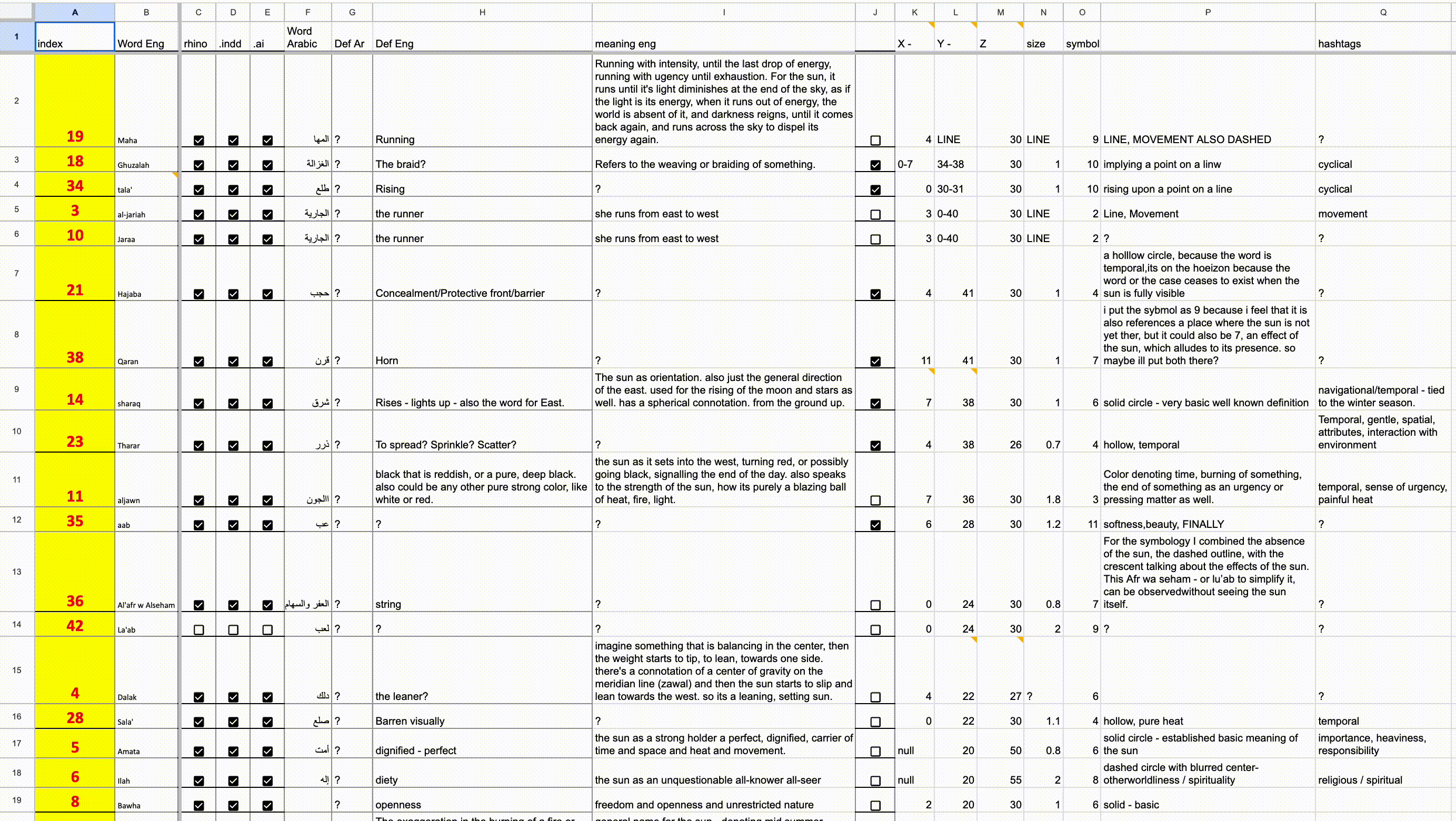
Parametric Process:
- Define primary environmental variables
Map out:- X (solar altitude)
- Y (solar azimuth)
- Z (temporal-spatial weight)
Then also an index for size & symbol.
- Assign sun height (X) based on seasons:
- X = 0 is maximum altitude at summer solstice
- X = 9 is minimum altitude at winter solstice
- X = -9 to -18 solar depression angles (civil, nautical, astronomical twilight)
- Assign east-west (Y) based on diurnal arc:
- Y = 0 is sunrise (maximum east)
- Y = 20 is noon (midpoint)
- Y = 40 is sunset (maximum west)
- Assign temporal-spatial index:
The Z-axis scale at 30 indicates a temporal concept (e.g., noon, dusk),
and 0 indicates a spatial or navigational concept (e.g., position in relation to land or structures).
- Assign symbol / size:
The symbology is highlighted in the next pages, and the size (from 0 to 1) indicates intensity / seeming closeness to the sun.
- Input into a parametric system:
Using Grasshopper, the parameters are embedded into a dynamic system, which can result in a visualization of the sun’s names as a zone, arc, or duration on the map.
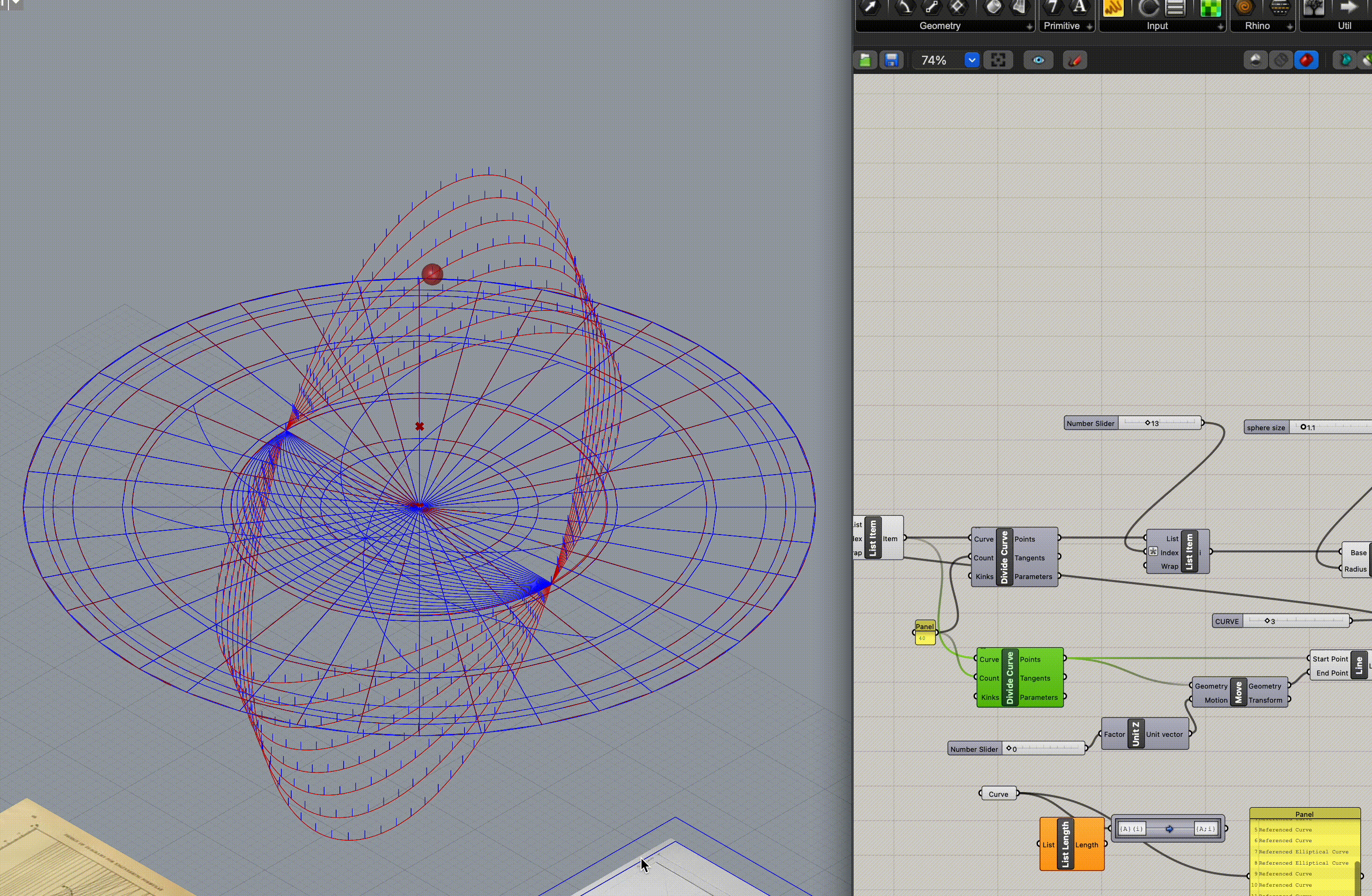
An example of this process:
#A22 - DANAF
(A - Names of the sun, B - Houses of the moon, C - Celestial (star) groupings)
Danaf (دنف) - A word that refers to the peak of an illness, the moment of most intense suffering, just before healing begins.
Temporal/Spatial Logic:
This word refers to when the sun is in the last stages of sunset, but maintains its intensity, so when it finally does set, there is a sense of relief. This is according to my own interpretation.
Temporally it refers to the last intense burst of heat of a summer sunset before the coolness of night takes over.
• A digital sundial that uses your location and season to offer sun names aligned with your lived sky;
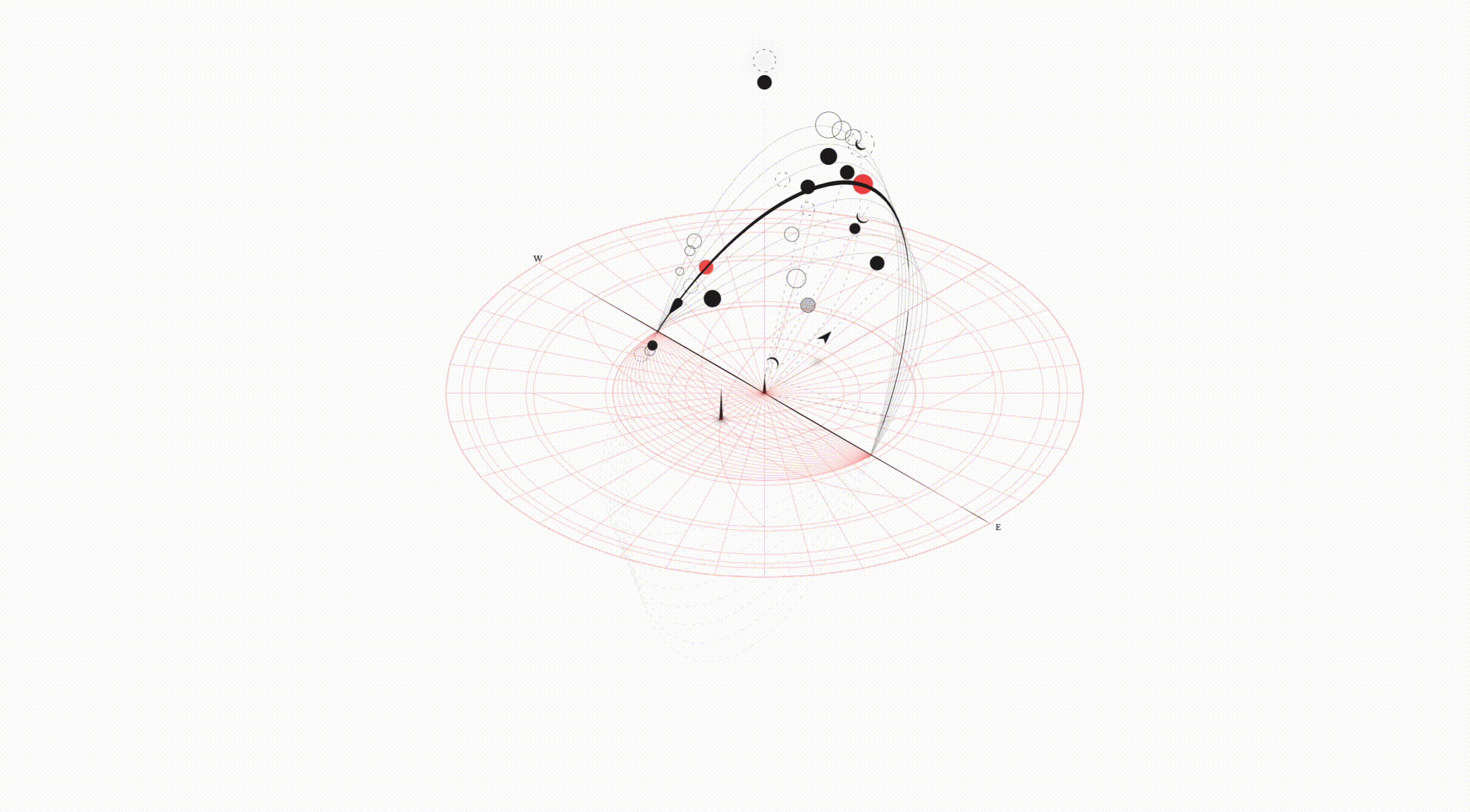
• A sun pointer built in p5.js, where your computer vision turns your finger into a tool to navigate a visual, spatial version of the sun names research;
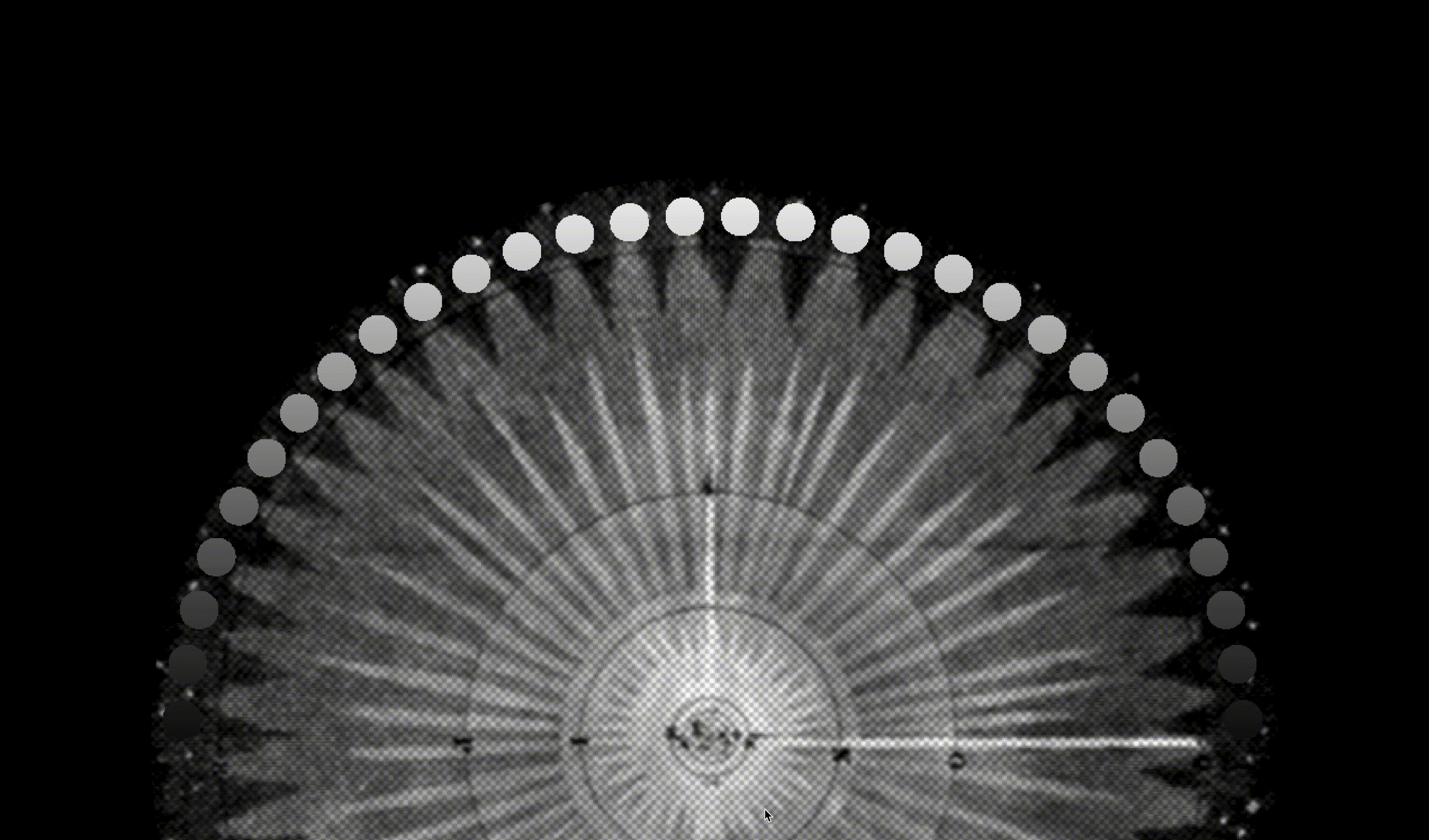
• An IFTTT notification system that retrains your sense of time by sending you the current name of the sun, then shows you what you should be seeing;
And a few more odd experiments, documented on the Resistant Atlas website.
Eventually, the research became a book, Resistant Atlas: Names of the Sun, which is a printed and bound index of all the sun names, organized, explained, and visualized across the sky.
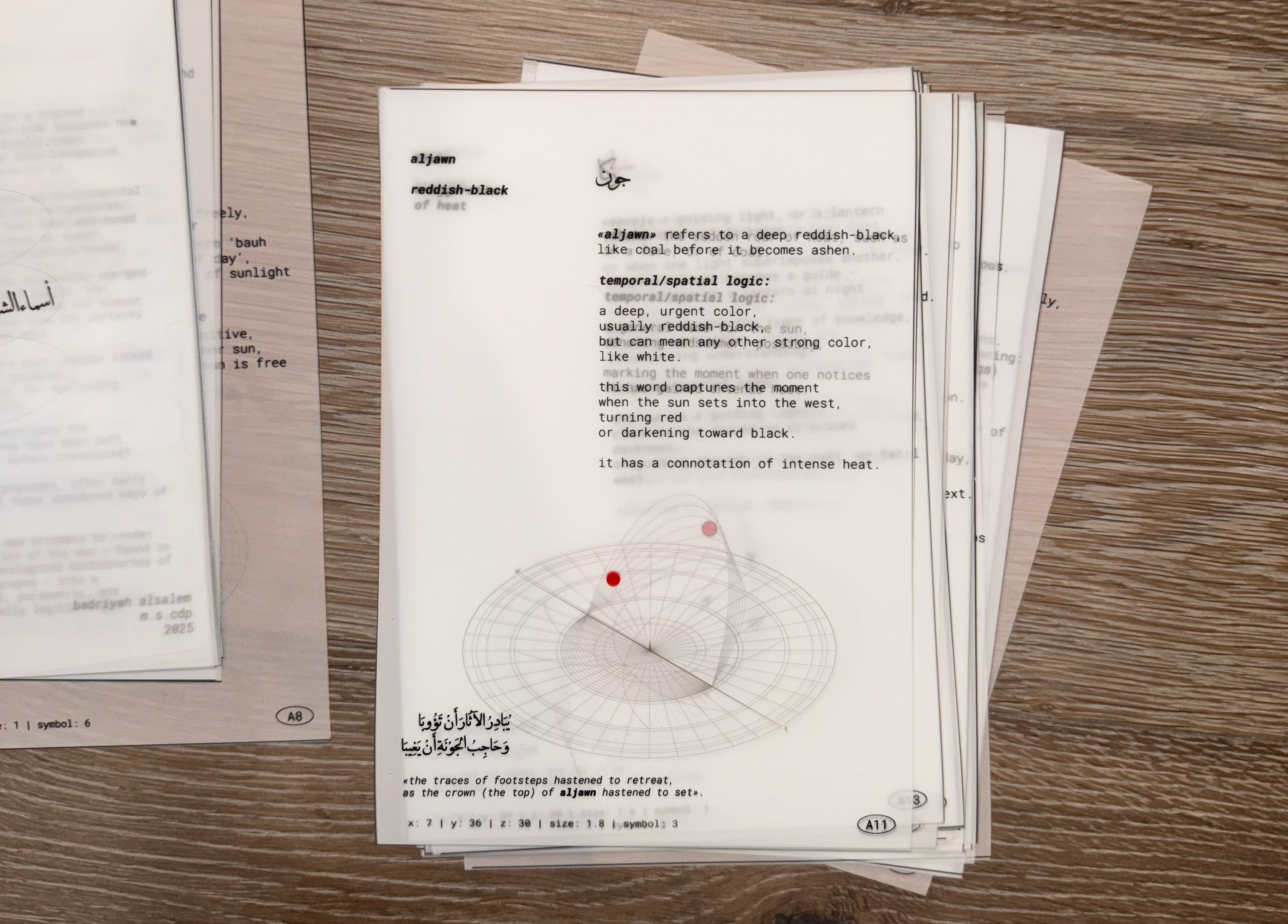
SUNDIAL
1. Reverse Sundial (Daytime Use)
A 5-ft diameter acrylic reverse sundial that uses the sun’s gleam (instead of its shadow) to reveal which sun from Resistant Atlas: Names of the Sun corresponds to the sun overhead.
Rather than telling time, it translates the sun’s visual alignment into definitions drawn from the meteorology archives. The main takeaway is that the time is told from the perception of how the sun feels and appears, rather than astronomical accuracy.
(Which, in the context of my research, is more important anyway. See the essay “It’s Inaccurate? Even Better!” on the website.)
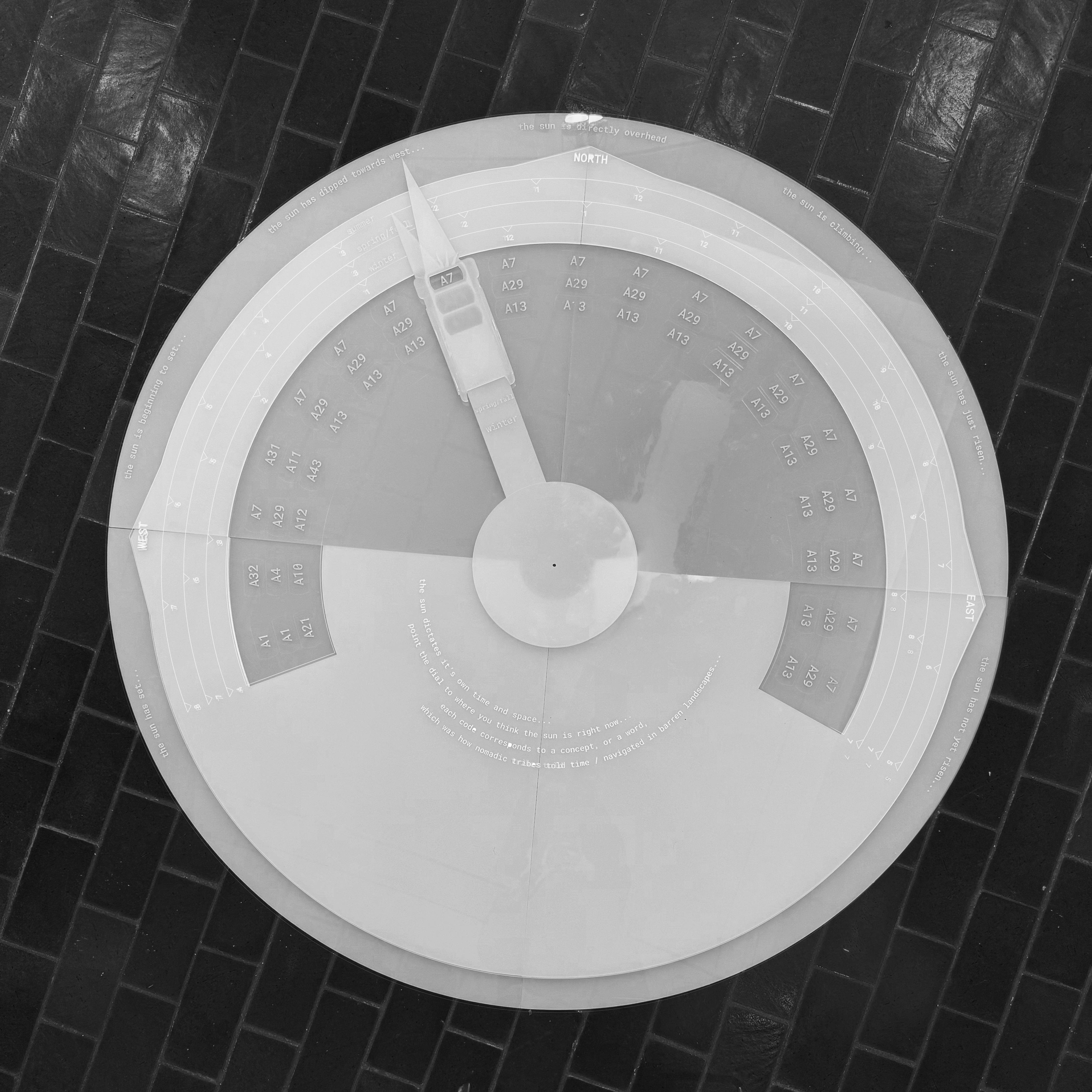
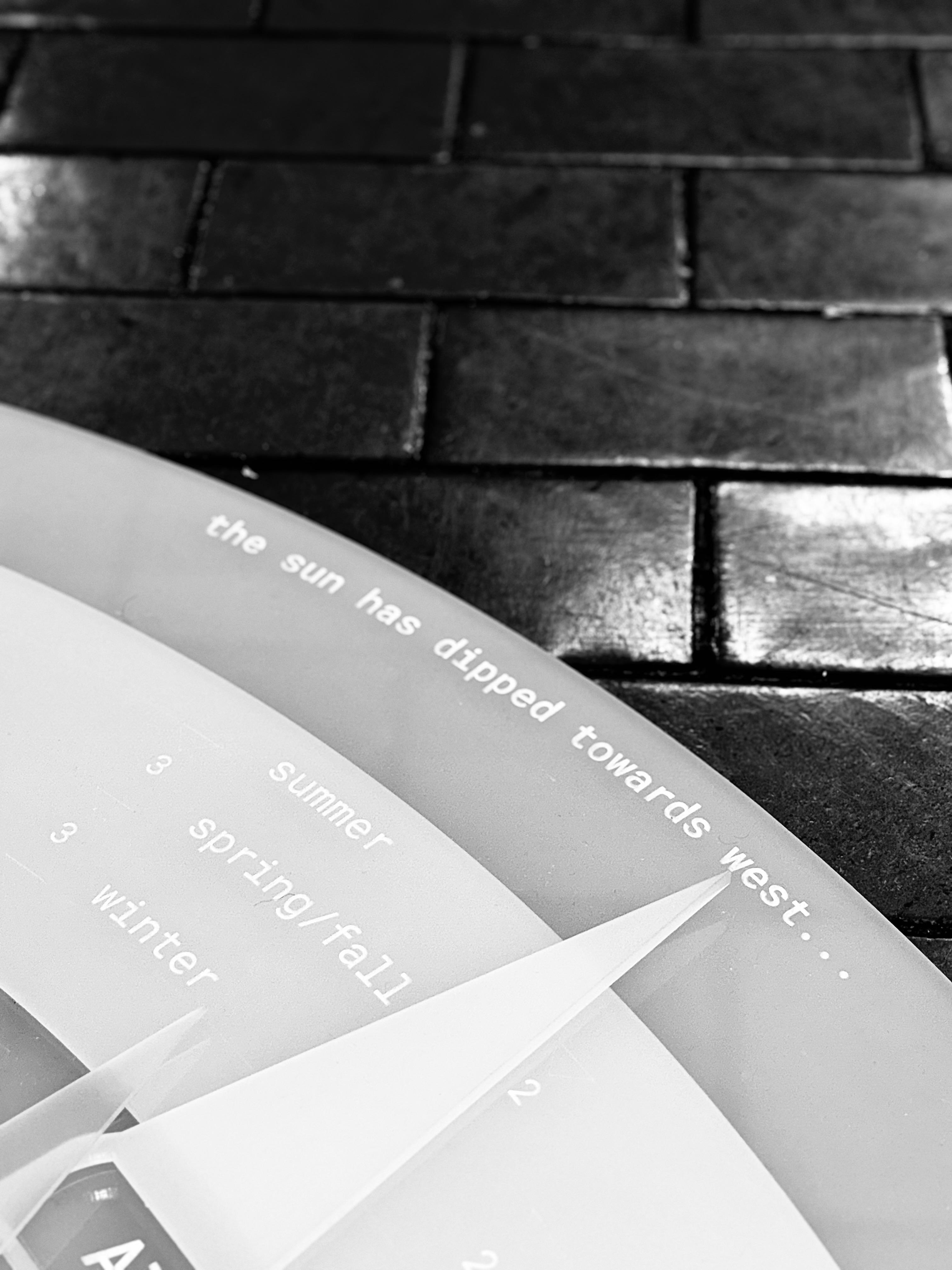
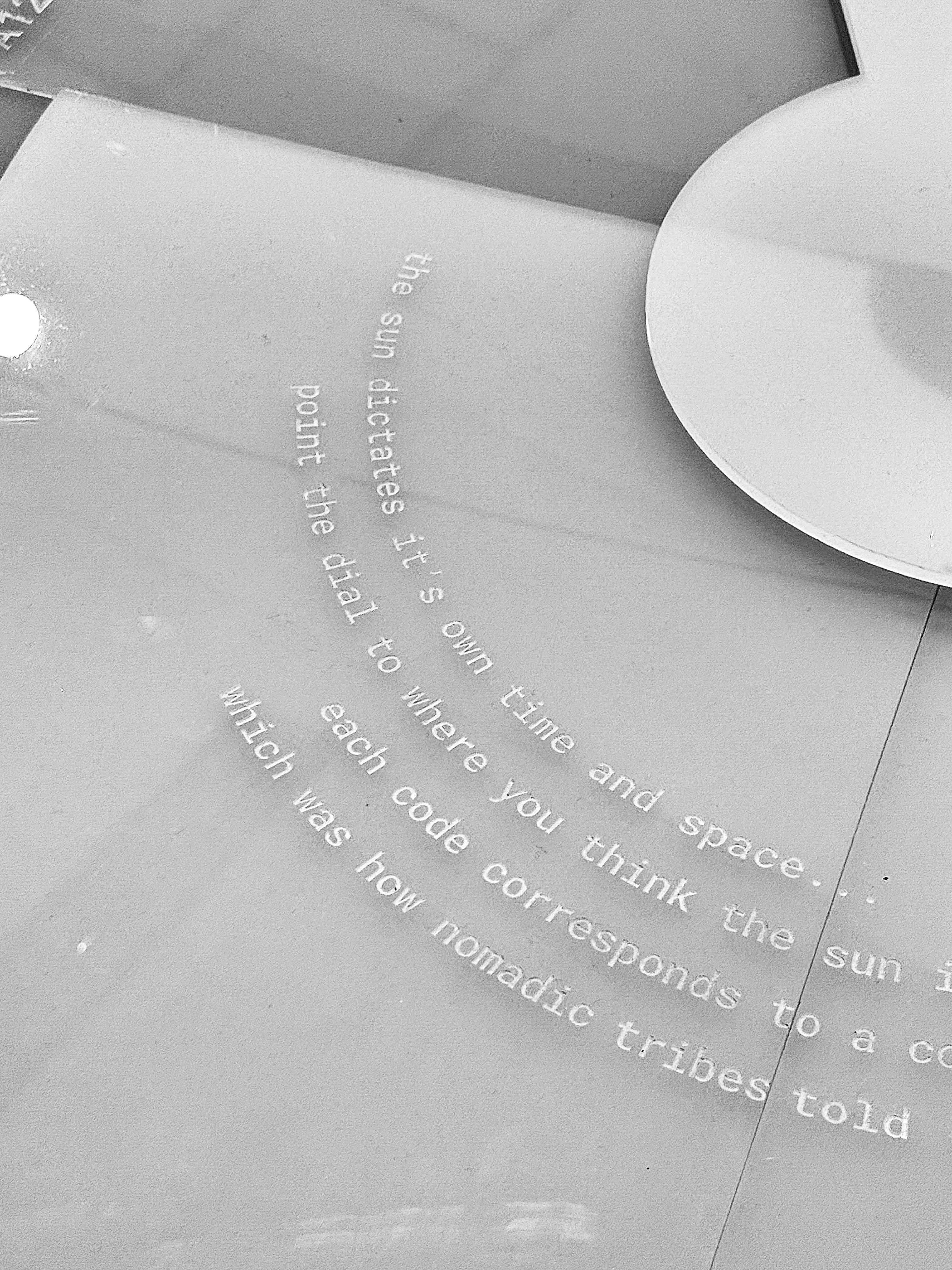

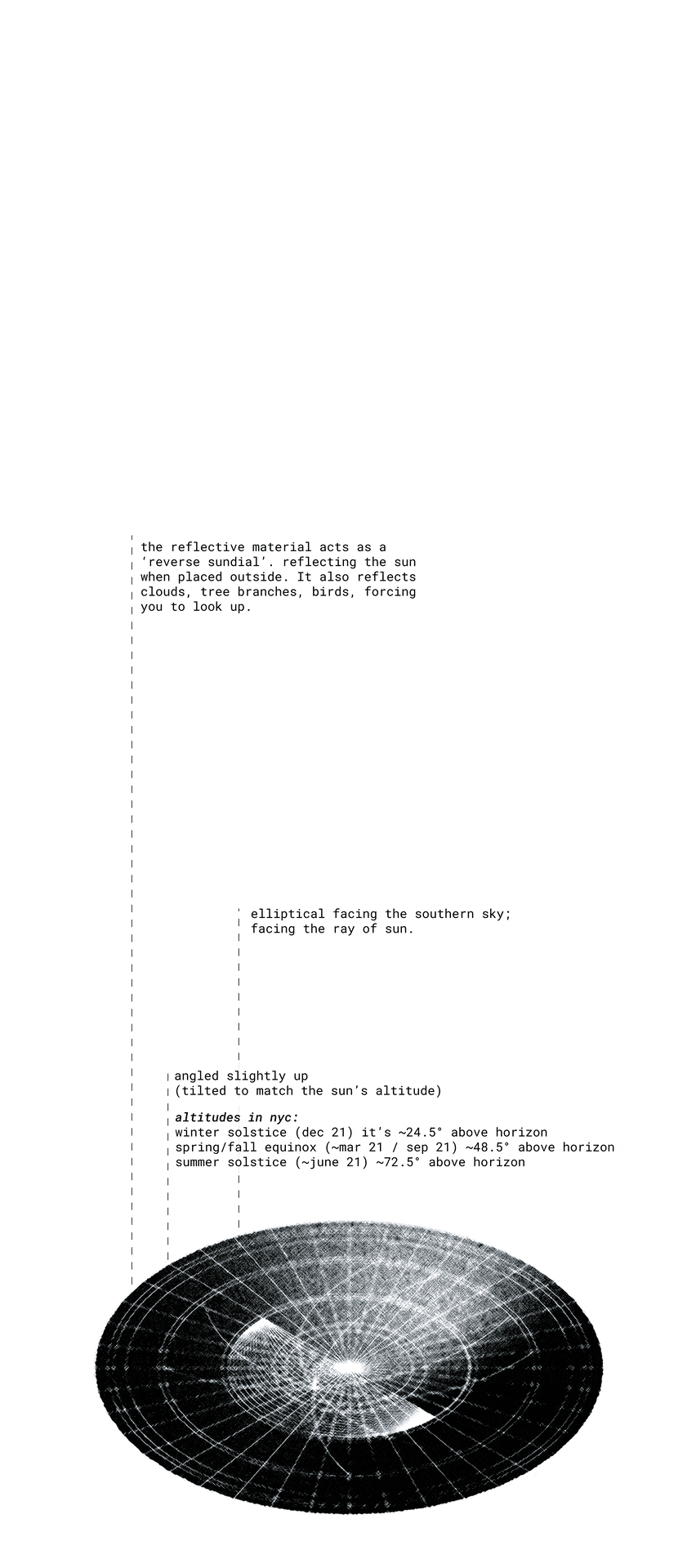
2. Reverse Sundial (Nighttime Use)
After dark, or indoors, the sundial transforms into an interactive installation. A projected interface maps onto the dial, and as the arm moves, it dynamically updates to display the corresponding sun name in real time.
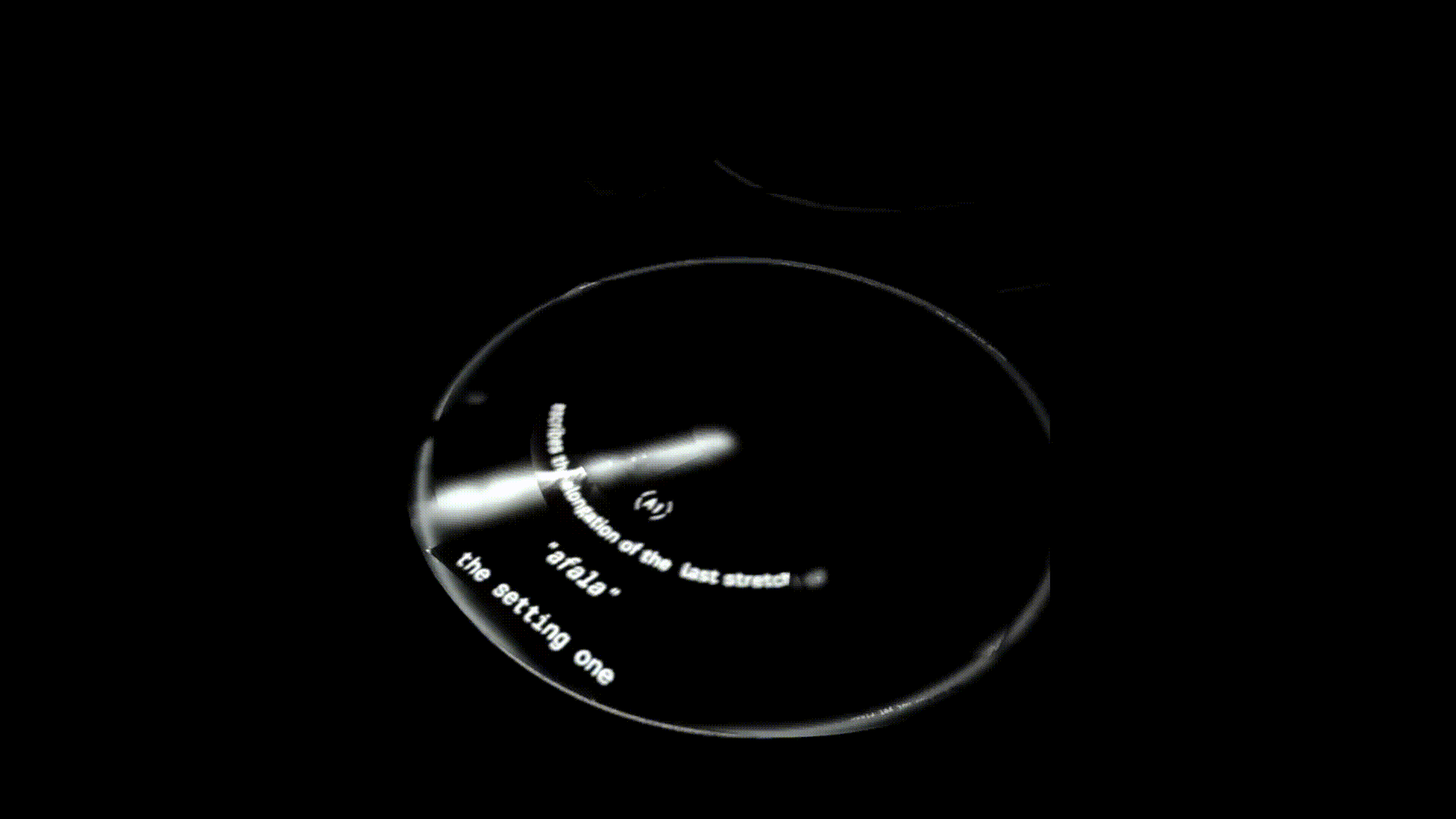

3. Sundial remote
A handheld sundial that links to the larger installation. Viewers can point toward any part of the sky, and the projected dial responds in real time. This reintroduces embodied, environmental logic through a system built with Arduino, ESP32, JavaScript, and TouchDesigner.
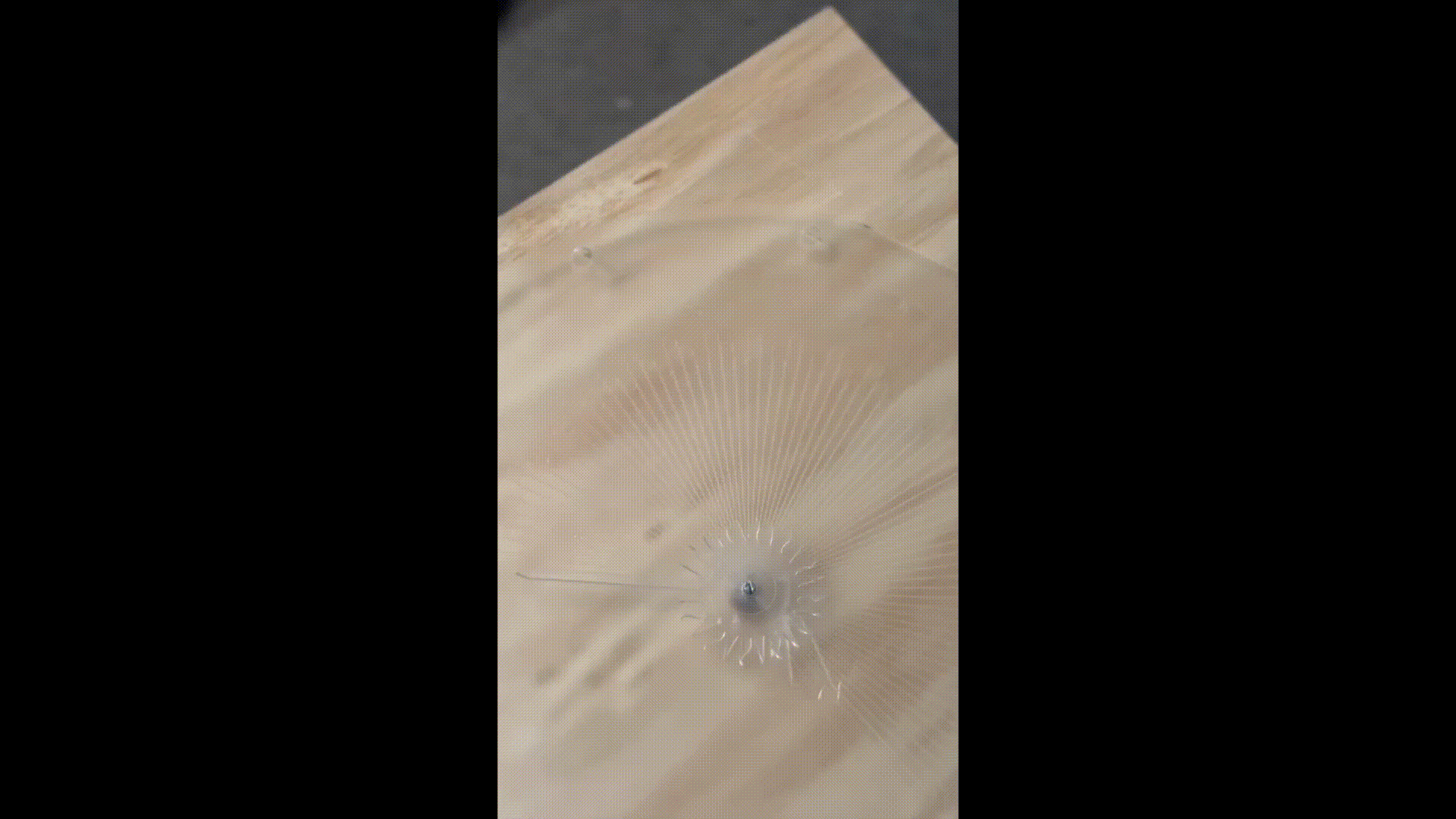
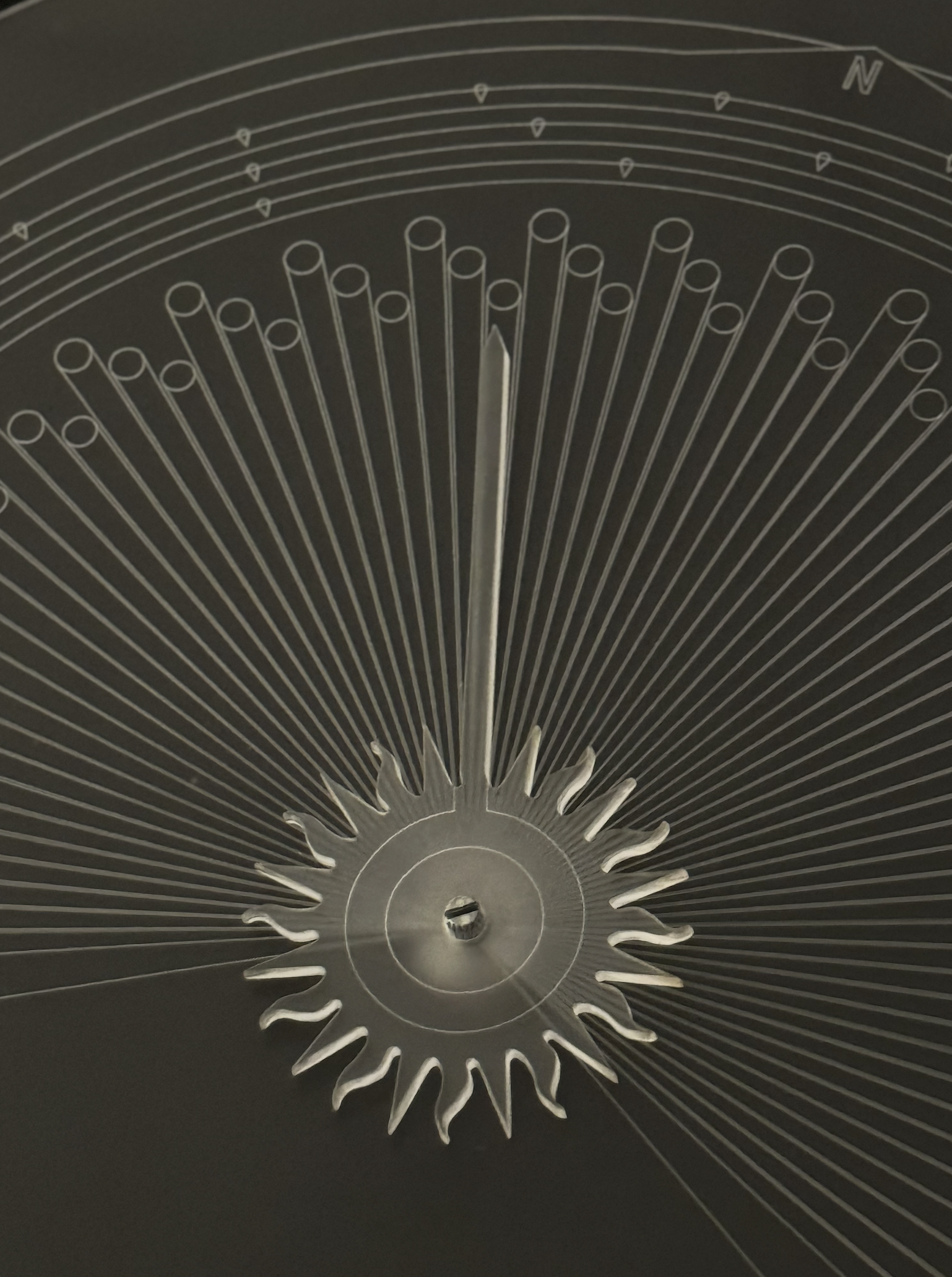
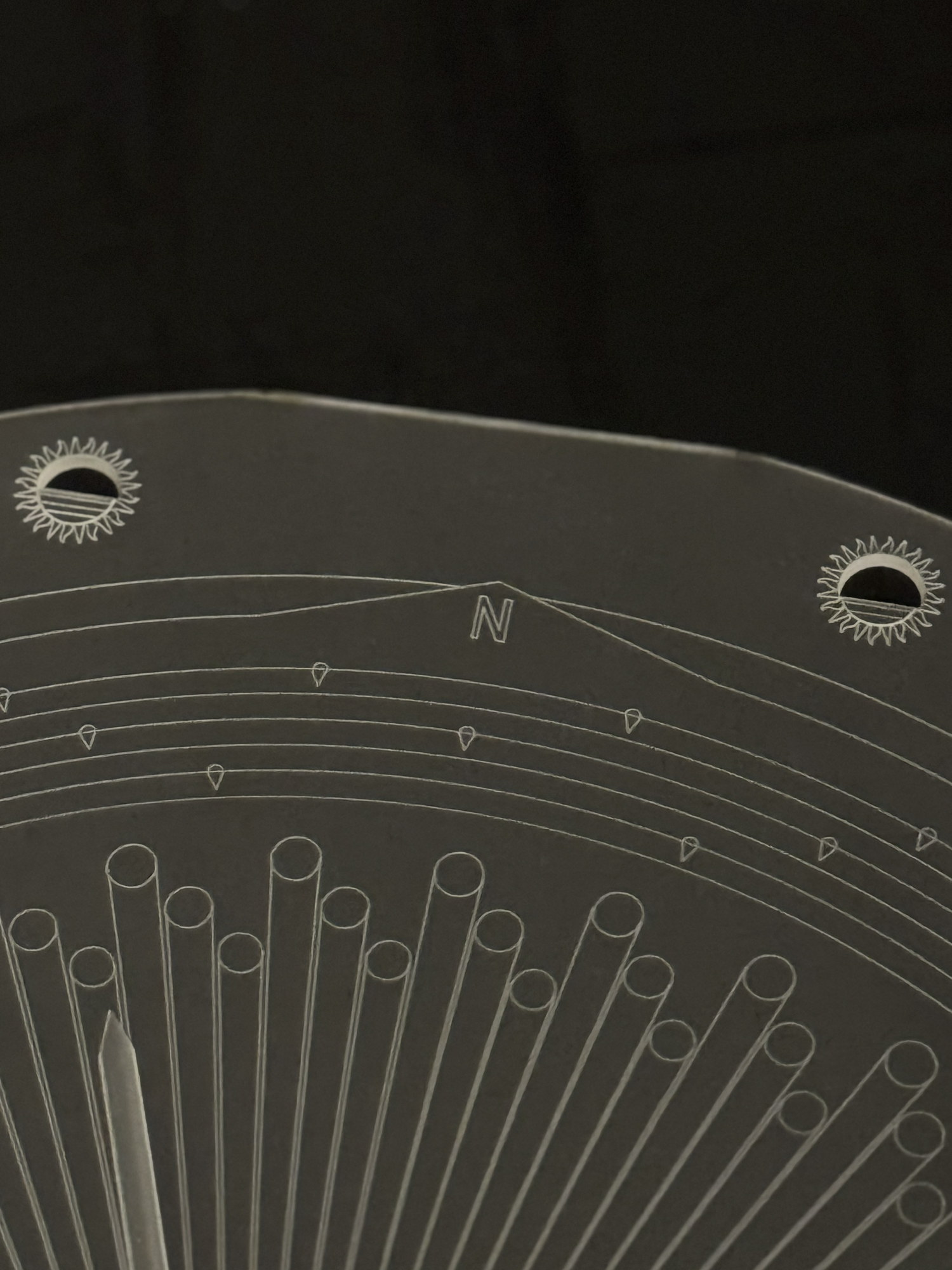
The above remote is connected to the larger projection and controls it in real time.
4. Pamphlets
A collection of pamphlets outlining the methodology of Names of the Sun and related projects like Houses of the Moon and Cloudspotter.
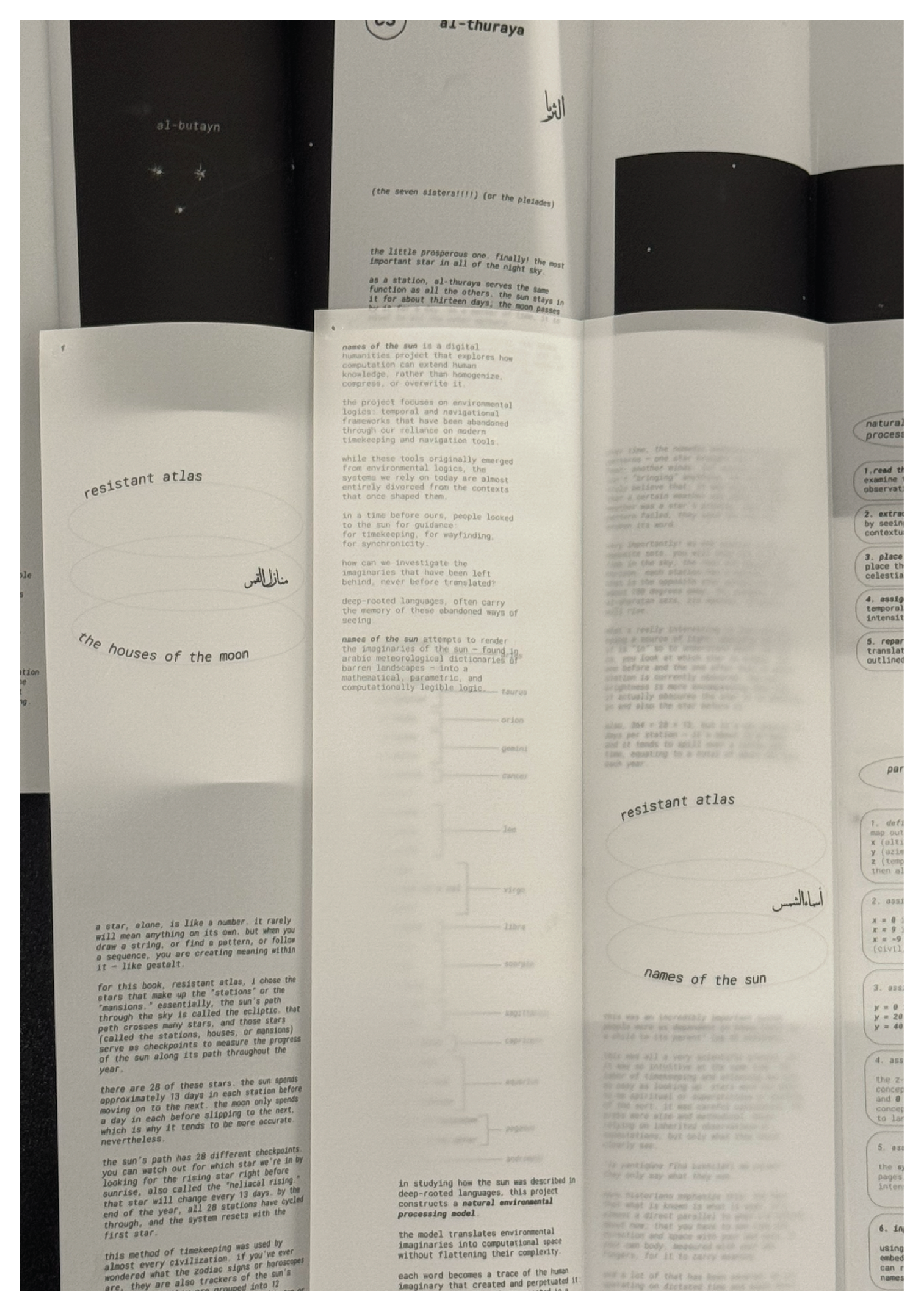
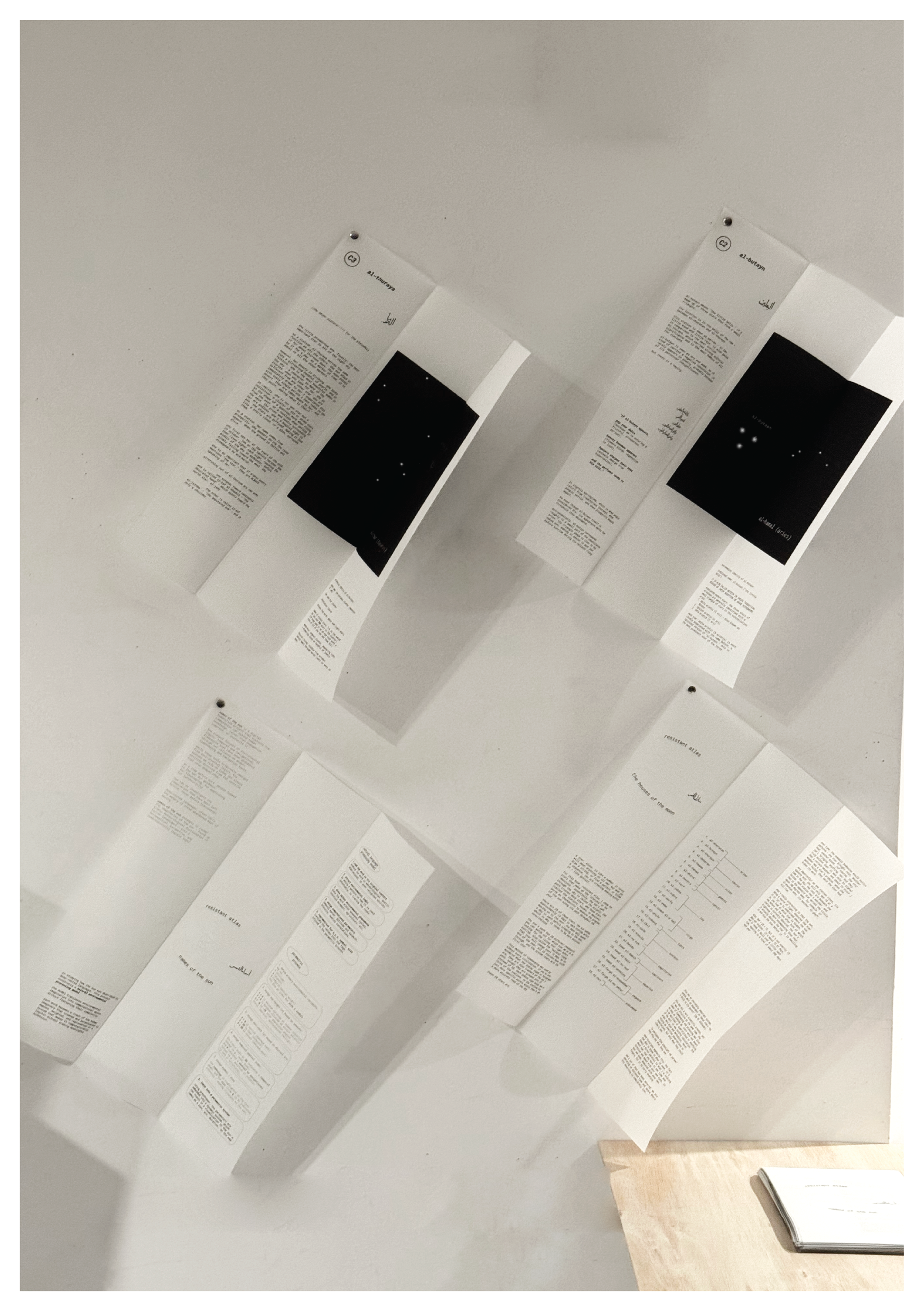
Upcoming Projects: Houses of the Moon
The next exploration is a study of lunar stations, or where the moon appears to mark the night sky, and the intricate environmental logic they chart over time. These movements hold immense historical, navigational, and poetic significance, and shaped the temporal and spatial frameworks we know today.
